2019 KIA FORTE traction control
[x] Cancel search: traction controlPage 17 of 550

Safety features of your vehicle
Important safety precautions . . . . . . . . . . . . . . . . . 3-2
• Always wear your seat belt. . . . . . . . . . . . . . . . . . . . . . 3-2
• Restrain all children . . . . . . . . . . . . . . . . . . . . . . . . . . . 3-2
• Air bag hazards . . . . . . . . . . . . . . . . . . . . . . . . . . . . . . . 3-2
• Driver distraction . . . . . . . . . . . . . . . . . . . . . . . . . . . . . 3-2
• Control your speed . . . . . . . . . . . . . . . . . . . . . . . . . . . . 3-3
• Keep your vehicle in safe condition . . . . . . . . . . . . . . . 3-3
Seat. . . . . . . . . . . . . . . . . . . . . . . . . . . . . . . . . . . . \
. . . 3-4
• Driver’s seat . . . . . . . . . . . . . . . . . . . . . . . . . . . . . . . . . . 3-4
• Front passenger’s seat. . . . . . . . . . . . . . . . . . . . . . . . . . 3-4
• Rear seat . . . . . . . . . . . . . . . . . . . . . . . . . . . . . . . . . . . . \
. 3-4
• Front seat adjustment -manual . . . . . . . . . . . . . . . . . . 3-7
• Front seat adjustment - power . . . . . . . . . . . . . . . . . . . 3-8
• Headrest (For front seat) . . . . . . . . . . . . . . . . . . . . . . 3-10
• Seatback pocket . . . . . . . . . . . . . . . . . . . . . . . . . . . . . . 3-13
• Rear seat adjustment . . . . . . . . . . . . . . . . . . . . . . . . . 3-13
Seat belts . . . . . . . . . . . . . . . . . . . . . . . . . . . . . . . . . 3-18
• Seat belt restraint system . . . . . . . . . . . . . . . . . . . . . . 3-18
• Pre-tensioner seat belt . . . . . . . . . . . . . . . . . . . . . . . . 3-25
• Seat belt precautions . . . . . . . . . . . . . . . . . . . . . . . . . . 3-28
• Care of seat belts . . . . . . . . . . . . . . . . . . . . . . . . . . . . . 3-30
Child Restraint System (CRS) . . . . . . . . . . . . . . . 3-32
• Children Always in the Rear . . . . . . . . . . . . . . . . . . . 3-32
• Selecting a Child Restraint System (CRS) . . . . . . . . 3-33
• Installing a Child Restraint System (CRS) . . . . . . . . 3-36
Air bag - advanced supplementalrestraint system . . . . . . . . . . . . . . . . . . . . . . . . . . 3-43
• How does the air bag system operate? . . . . . . . . . . . 3-44
• Air bag warning light . . . . . . . . . . . . . . . . . . . . . . . . . 3-46
• SRS components and functions . . . . . . . . . . . . . . . . . 3-47
• Occupant Detection System (ODS) . . . . . . . . . . . . . . 3-50
• Driver's and passenger's front air bag . . . . . . . . . . . 3-58
• Side air bag . . . . . . . . . . . . . . . . . . . . . . . . . . . . . . . . . 3-60
• Curtain air bag . . . . . . . . . . . . . . . . . . . . . . . . . . . . . . 3-62
• SRS Care . . . . . . . . . . . . . . . . . . . . . . . . . . . . . . . . . . . 3-\
68
• Adding equipment to or modifying your air
bag-equipped vehicle. . . . . . . . . . . . . . . . . . . . . . . . . 3-69
• Air bag warning label . . . . . . . . . . . . . . . . . . . . . . . . . 3-693
BDm CAN (ENG) 3.qxp 6/30/2018 1:41 PM Page 1
Page 267 of 550
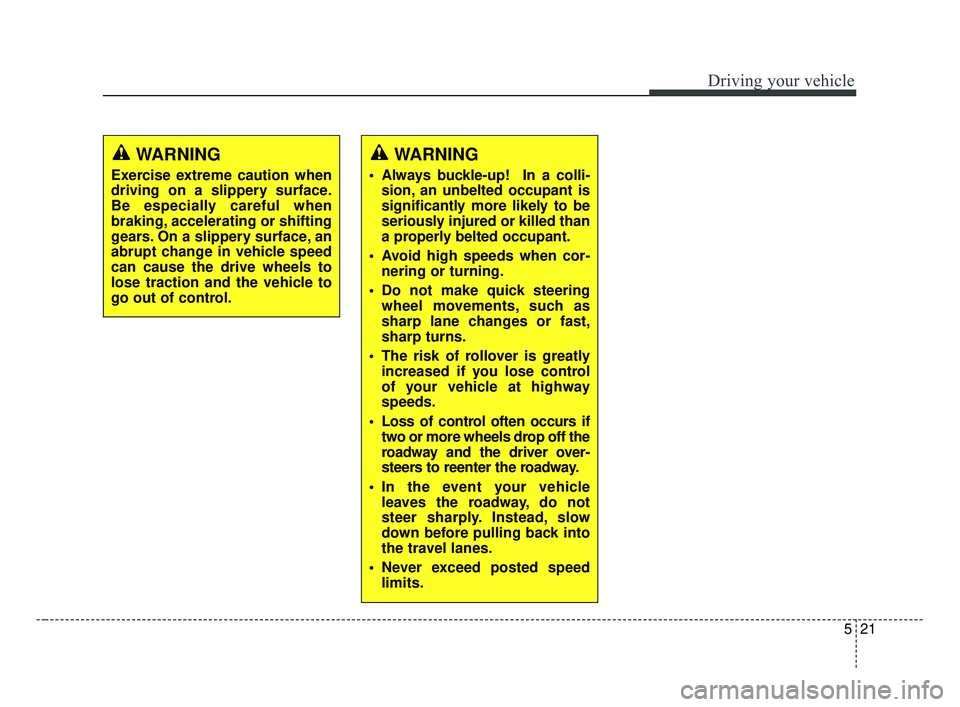
521
Driving your vehicle
WARNING
Always buckle-up! In a colli-sion, an unbelted occupant is
significantly more likely to be
seriously injured or killed than
a properly belted occupant.
Avoid high speeds when cor- nering or turning.
Do not make quick steering wheel movements, such as
sharp lane changes or fast,
sharp turns.
The risk of rollover is greatly increased if you lose control
of your vehicle at highway
speeds.
Loss of control often occurs if two or more wheels drop off the
roadway and the driver over-
steers to reenter the roadway.
In the event your vehicle leaves the roadway, do not
steer sharply. Instead, slow
down before pulling back into
the travel lanes.
Never exceed posted speed limits.
WARNING
Exercise extreme caution when
driving on a slippery surface.
Be especially careful when
braking, accelerating or shifting
gears. On a slippery surface, an
abrupt change in vehicle speed
can cause the drive wheels to
lose traction and the vehicle to
go out of control.
BDm CAN (ENG) 5.QXP 7/4/2018 10:13 AM Page 21
Page 275 of 550
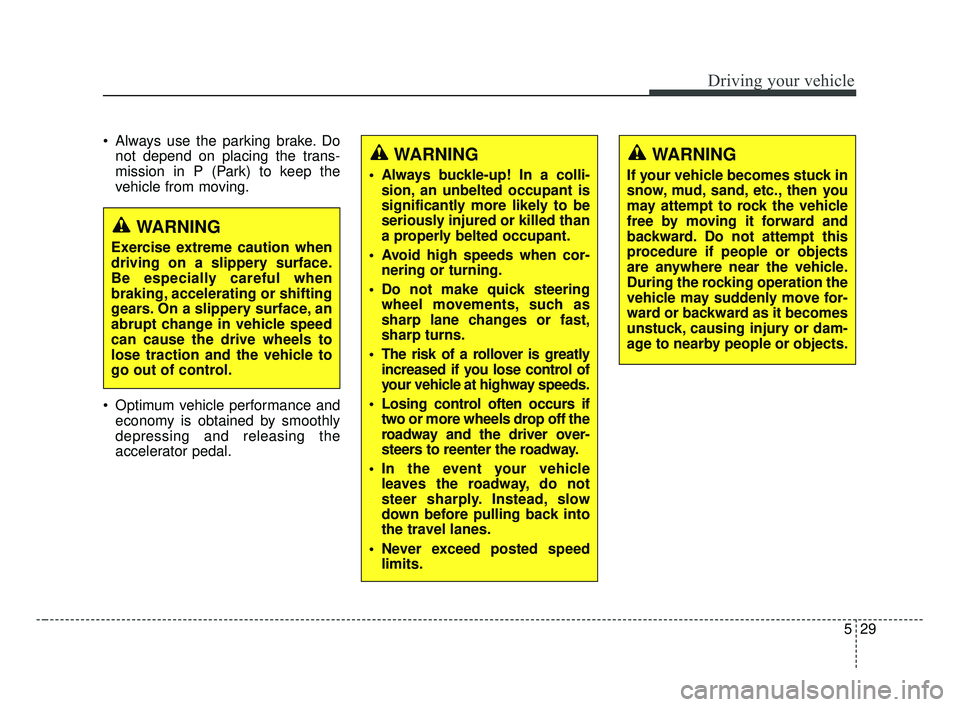
529
Driving your vehicle
Always use the parking brake. Donot depend on placing the trans-
mission in P (Park) to keep the
vehicle from moving.
Optimum vehicle performance and economy is obtained by smoothly
depressing and releasing the
accelerator pedal.
WARNING
Always buckle-up! In a colli-sion, an unbelted occupant is
significantly more likely to be
seriously injured or killed than
a properly belted occupant.
Avoid high speeds when cor- nering or turning.
Do not make quick steering wheel movements, such as
sharp lane changes or fast,
sharp turns.
The risk of a rollover is greatly increased if you lose control of
your vehicle at highway speeds.
Losing control often occurs if two or more wheels drop off the
roadway and the driver over-
steers to reenter the roadway.
In the event your vehicle leaves the roadway, do not
steer sharply. Instead, slow
down before pulling back into
the travel lanes.
Never exceed posted speed limits.
WARNING
If your vehicle becomes stuck in
snow, mud, sand, etc., then you
may attempt to rock the vehicle
free by moving it forward and
backward. Do not attempt this
procedure if people or objects
are anywhere near the vehicle.
During the rocking operation the
vehicle may suddenly move for-
ward or backward as it becomes
unstuck, causing injury or dam-
age to nearby people or objects.
WARNING
Exercise extreme caution when
driving on a slippery surface.
Be especially careful when
braking, accelerating or shifting
gears. On a slippery surface, an
abrupt change in vehicle speed
can cause the drive wheels to
lose traction and the vehicle to
go out of control.
BDm CAN (ENG) 5.QXP 7/4/2018 10:13 AM Page 29
Page 283 of 550

537
Driving your vehicle
The ABS warning light will stay on for
approximately 3 seconds after the
ignition switch is ON. During that
time, the ABS will go through self-
diagnosis and the light will go off if
everything is normal. If the light stays
on, you may have a problem with
your ABS. Contact an authorized Kia
dealer as soon as possible. When you drive on a road having
poor traction, such as an icy road,
and have operated your brakes
continuously, the ABS will be active
continuously and the ABS warning
light may illuminate. Pull your vehi-
cle over to a safe place and stop
the engine.
Restart the engine. If the ABS warning light goes off, then your
ABS system is normal. Otherwise,
you may have a problem with the
ABS. Contact an authorized Kia
dealer as soon as possible.
✽ ✽ NOTICE
When you jump start your vehicle
because of a drained battery, the
engine may not run as smoothly and
the ABS warning light may turn on at
the same time. This happens because
of low battery voltage. It does not
mean your ABS has malfunctioned.
• Do not pump your brakes!
• Have the battery recharged before
driving the vehicle.
Electronic stability control
(ESC)
The Electronic Stability control
(ESC) system is designed to stabi-
lize the vehicle during cornering
maneuvers. ESC checks where you
are steering and where the vehicle is
actually going. ESC applies the
brakes on individual wheels and
intervenes with the engine manage-
ment system to stabilize the vehicle.
W-78
OBD058013
BDm CAN (ENG) 5.QXP 7/4/2018 10:13 AM Page 37
Page 284 of 550
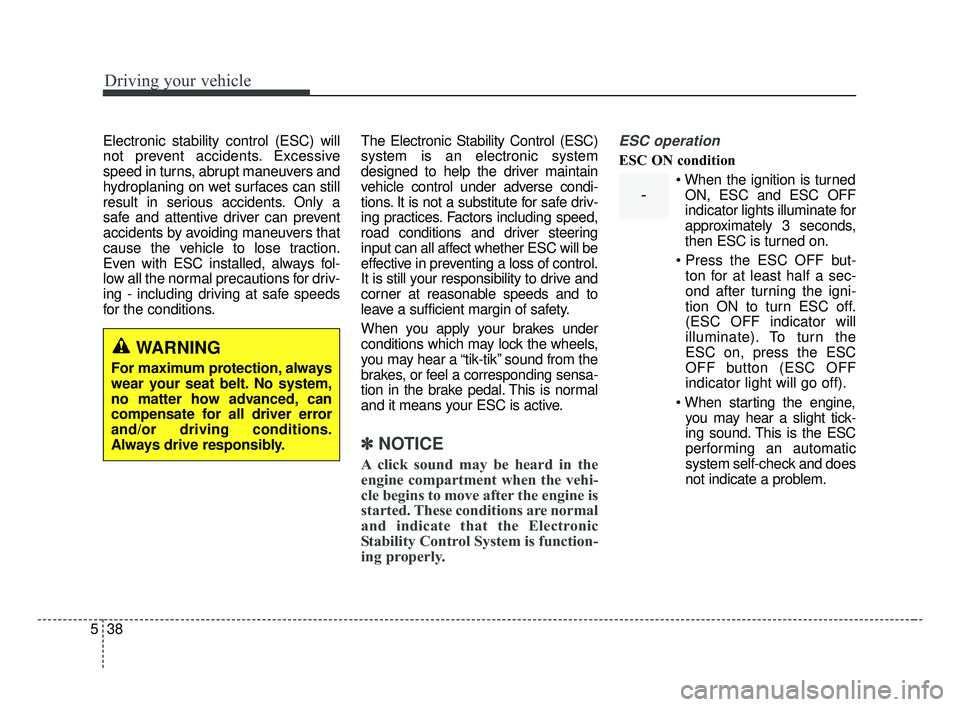
Driving your vehicle
38
5
Electronic stability control (ESC) will
not prevent accidents. Excessive
speed in turns, abrupt maneuvers and
hydroplaning on wet surfaces can still
result in serious accidents. Only a
safe and attentive driver can prevent
accidents by avoiding maneuvers that
cause the vehicle to lose traction.
Even with ESC installed, always fol-
low all the normal precautions for driv-
ing - including driving at safe speeds
for the conditions. The Electronic Stability Control (ESC)
system is an electronic system
designed to help the driver maintain
vehicle control under adverse condi-
tions. It is not a substitute for safe driv-
ing practices. Factors including speed,
road conditions and driver steering
input can all affect whether ESC will be
effective in preventing a loss of control.
It is still your responsibility to drive and
corner at reasonable speeds and to
leave a sufficient margin of safety.
When you apply your brakes under
conditions which may lock the wheels,
you may hear a “tik-tik’’ sound from the
brakes, or feel a corresponding sensa-
tion in the brake pedal. This is normal
and it means your ESC is active.
✽ ✽
NOTICE
A click sound may be heard in the
engine compartment when the vehi-
cle begins to move after the engine is
started. These conditions are normal
and indicate that the Electronic
Stability Control System is function-
ing properly.
ESC operation
ESC ON condition
When the ignition is turnedON, ESC and ESC OFF
indicator lights illuminate for
approximately 3 seconds,
then ESC is turned on.
ton for at least half a sec-
ond after turning the igni-
tion ON to turn ESC off.
(ESC OFF indicator will
illuminate). To turn the
ESC on, press the ESC
OFF button (ESC OFF
indicator light will go off).
you may hear a slight tick-
ing sound. This is the ESC
performing an automatic
system self-check and does
not indicate a problem.
WARNING
For maximum protection, always
wear your seat belt. No system,
no matter how advanced, can
compensate for all driver error
and/or driving conditions.
Always drive responsibly.
-
BDm CAN (ENG) 5.QXP 7/4/2018 10:13 AM Page 38
Page 285 of 550
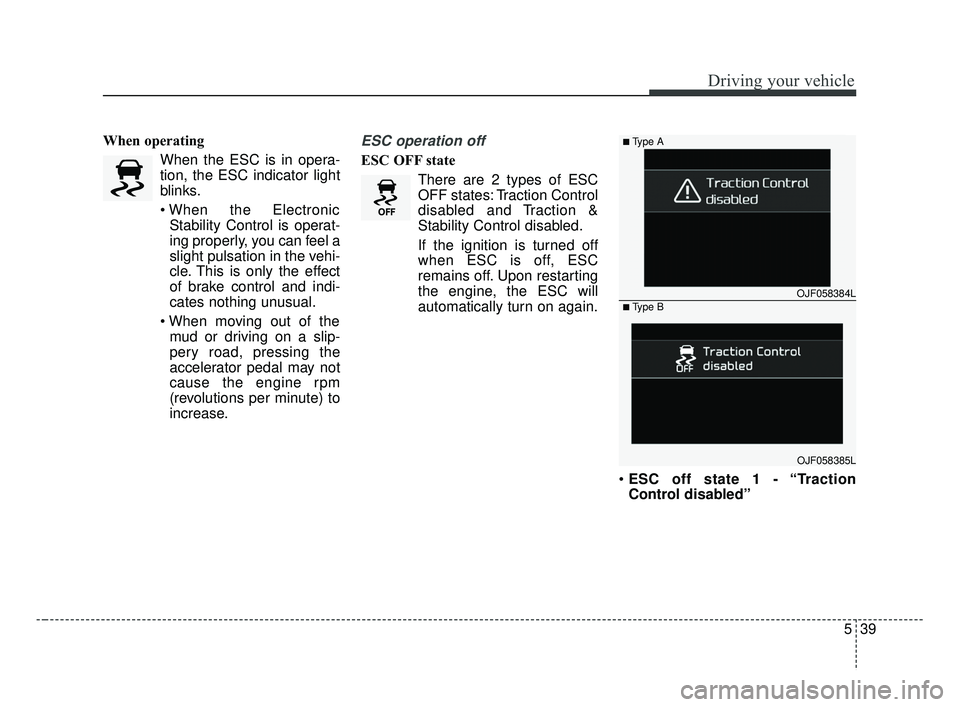
539
Driving your vehicle
When operatingWhen the ESC is in opera-
tion, the ESC indicator light
blinks.
Stability Control is operat-
ing properly, you can feel a
slight pulsation in the vehi-
cle. This is only the effect
of brake control and indi-
cates nothing unusual.
mud or driving on a slip-
pery road, pressing the
accelerator pedal may not
cause the engine rpm
(revolutions per minute) to
increase.ESC operation off
ESC OFF state
There are 2 types of ESC
OFF states: Traction Control
disabled and Traction &
Stability Control disabled.
If the ignition is turned off
when ESC is off, ESC
remains off. Upon restarting
the engine, the ESC will
automatically turn on again.
ESC off state 1 - “Traction
Control disabled”
OJF058384L
■Type A
■Type B
OJF058385L
BDm CAN (ENG) 5.QXP 7/4/2018 10:13 AM Page 39
Page 286 of 550
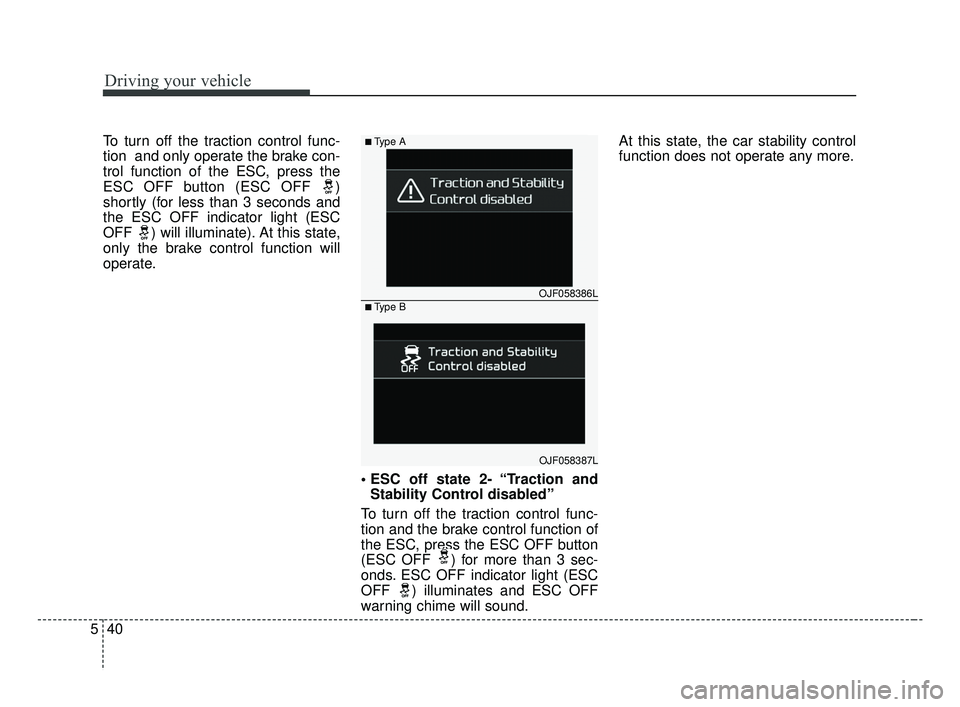
Driving your vehicle
40
5
To turn off the traction control func-
tion and only operate the brake con-
trol function of the ESC, press the
ESC OFF button (ESC OFF )
shortly (for less than 3 seconds and
the ESC OFF indicator light (ESC
OFF ) will illuminate). At this state,
only the brake control function will
operate.
Stability Control disabled”
To turn off the traction control func-
tion and the brake control function of
the ESC, press the ESC OFF button
(ESC OFF ) for more than 3 sec-
onds. ESC OFF indicator light (ESC
OFF ) illuminates and ESC OFF
warning chime will sound. At this state, the car stability control
function does not operate any more.
OJF058386L
■Type A
■Type B
OJF058387L
BDm CAN (ENG) 5.QXP 7/4/2018 10:13 AM Page 40
Page 377 of 550

5131
Driving your vehicle
Driving in flooded areas
Avoid driving through flooded areas
unless you are sure the water is no
higher than the bottom of the wheel
hub. Drive through any water slowly.
Allow adequate stopping distance
because brake performance may be
affected.
After driving through water, dry the
brakes by gently applying them sev-
eral times while the vehicle is moving
slowly.
Driving off-road
Drive carefully off-road because your
vehicle may be damaged by rocks or
roots of trees. Become familiar with
the off-road conditions where you
are going to drive before you begin
driving.
Highway driving
Tires
Adjust the tire inflation pressures to
specification. Low tire inflation pres-
sures will result in overheating and
possible failure of the tires.
Avoid using worn or damaged tires
which may result in reduced traction
or tire failure.
Never exceed the maximum tire
inflation pressure shown on the tires.
Fuel, engine coolant and engine oil
High speed travel consumes more
fuel than urban motoring. Do not for-
get to check both the engine coolant
and engine oil.
Drive belt
A loose or damaged drive belt may
result in overheating of the engine.
WARNING- Under/overinflated tires
Always check the tires for proper
inflation before driving.
Underinflated or overinflated
tires can cause poor handling,
loss of vehicle control, and sud-
den tire failure leading to acci-
dents, injuries, and even death.
For proper tire pressures, refer to
“Tires and wheels” in chapter 9.
WARNING- Tire tread
Always check the tire tread
before driving your vehicle.
Worn-out tires can result in loss
of vehicle control. Worn-out tires
should be replaced as soon as
possible. For further information
and tread limits, refer to "Tires
and wheels" in chapter 8.
BDm CAN (ENG) 5.QXP 7/4/2018 10:18 AM Page 131